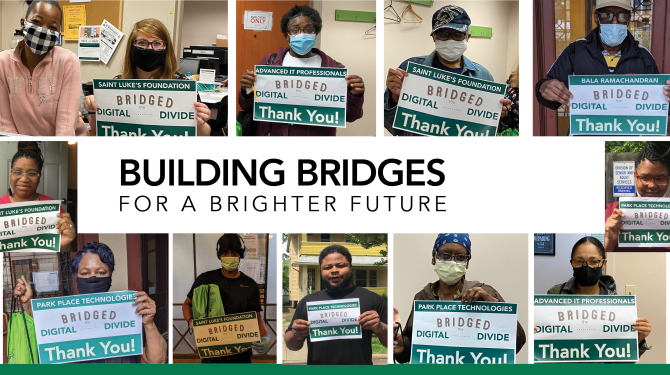Donors Help Bridge the Digital Divide

In the early weeks of the COVID-19 pandemic, as schools across the nation were closing their doors and moving to virtual instruction, news stories about the inequities in access to technology in some communities abounded. Reactions on social media underscored the degree to which those with access to technology take that access for granted. In the age where many households have multiple devices and consistent access to WiFi, learning that this is not the reality for many Americans was shocking to some.
WHAT WE KNEW
At Seeds of Literacy we have always been aware that the “digital divide” is real.
- We knew that the tentacles of having low literacy levels reach into all other areas of life.
- We knew that 75% of our incoming students were unable to pass a basic digital literacy assessment.
- We also knew that the majority of our students did not have computers at home, and that their education, and their children’s education, would be compromised without them.
When Governor DeWine issued the stay-at-home order for Ohio, our team focused immediately on providing tutoring services via telephone because we knew that the majority of our students had smartphones and knew how to use them to make and receive calls.
- We knew that using their phones would be the quickest path to preventing a disruption to student learning.
- We also knew that some of our tutors might also feel more comfortable using more basic forms of communication.
WHAT WE DID NEXT
Our team set out to find out what resources were available to get technology into the hands of our students so they could access our online learning options (video tutoring and live lessons created and facilitated by our amazing volunteer tutors). We reached out to providers to get free or low-cost WiFi to students. We spent hours on the phones waiting to talk to customer service representatives, and even more hours trying to clearly understand the terms of the agreements so that we could protect our students from getting billed later. We reached out to a few agencies in the community to find programs where students could borrow computers, or where we could purchase them at a low cost.
Of course we weren’t the only ones reaching out to these agencies, so getting return phone calls and emails seemed impossible.
IT TAKES A VILLAGE
Ultimately, it was the non-stop outreach efforts of our President & CEO Bonnie Entler, that allowed us to get devices into our students’ hands. Reaching out to funders and to her professional network, she was able to secure more than 50 donated computers that we were able to loan to students.
- Thanks to a generous grant from the St. Luke’s Foundation, we were able to purchase new desktop computers for our west side computer lab, and repurpose the older computers for our computer loan program.
- Park Place Technologies in Pepper Pike donated 35 laptops that we were able to make available to students.
- Our technology providers, Advanced IT Pros, took all of the donated computers and prepared them for the students free of charge. They removed old content, added Windows 10, and even placed shortcuts to our website and other important resources on the desktops for easy access.
- Our staff brought students into our east and west side locations (in small groups to follow social distancing guidelines) and provided some training on how to use the computers to access our online learning resources.
While we are still working toward increasing student engagement in our Virtual Classroom — and are still dealing with the complications that COVID-19 has thrust upon us all — we are grateful for the donations that helped us build a small bridge across the digital divide.
CHOICES & GRATITUDE
We are choosing to look at the opportunities that this situation presents.
We are choosing to focus on the “wins” that we witness daily.
We marvel at the tutors who quickly learned to navigate the technology to support our students.
We celebrate the students who were not comfortable using computers at all, but who now participate in online learning, attend social events virtually, and who are expanding their technology use.
We are grateful for the 227 students who have enrolled since our physical locations closed (two who have already graduated);those students have thanked us for offering learning options during COVID.
We are grateful that, while the barrier of technology still exists, the barrier of transportation has been eliminated as a result of our online options.
We are grateful that as an organization we continue to learn, grow, adapt, and expand.
While many will look at 2020 and remember only the bad, we will always see 2020 as the birth of our Virtual Classroom.
### Dr. Carmine Stewart, VP of Programming



